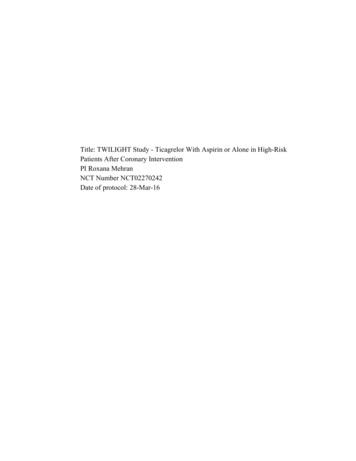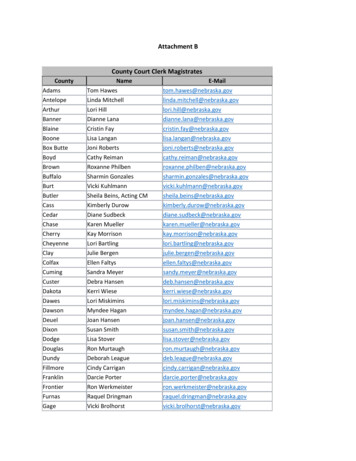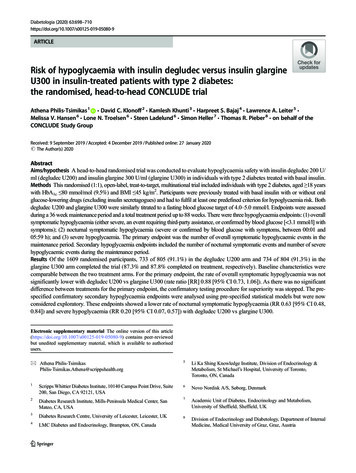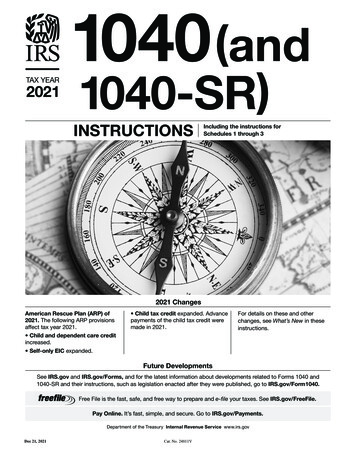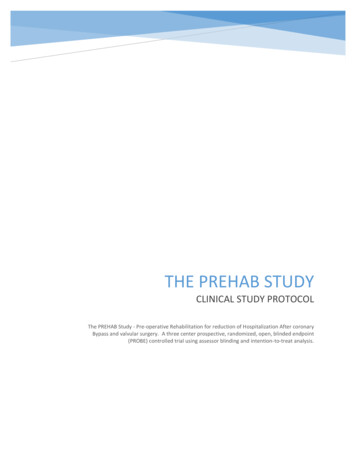
Transcription
THE PREHAB STUDYCLINICAL STUDY PROTOCOLThe PREHAB Study - Pre-operative Rehabilitation for reduction of Hospitalization After coronaryBypass and valvular surgery. A three center prospective, randomized, open, blinded endpoint(PROBE) controlled trial using assessor blinding and intention-to-treat analysis.
“The PREHAB Study” (Pre-operative Rehabilitation for reduction of Hospitalization After coronaryBypass and valvular surgery.)Study rs:J16Jan2019The PREHAB Study - Pre-operative Rehabilitation for reduction of HospitalizationAfter coronary Bypass and valvular surgery.Dr. Rakesh AroraEmail: rarora@sbgh.mb.caWork Phone: (204) 258-1031Work Fax:(204) 231-4624Institution: St. Boniface Hospital/University of ManitobaDepartment: Cardiac Sciences/SurgeryCR3012-I.H. Asper Institute, St. Boniface Hospital369 Tache Ave., Winnipeg, MB, R2H2A6Dr. Todd Duhamel204-474-8922 tduhamel@sbrc.ca Faculty of Kinesiology and Recreation Management University ofManitoba & Institute of Cardiovascular Sciences, St. Boniface Hospital.Dr. Ansar Hassan506-648-6102 ahassan@dal.ca New Brunswick Heart Centre -Saint John Regional HospitalDr. Nicholas Giacomantonio902-473-3815 Nicholas.Giacomantonio@cdha.nshealth.ca Dalhousie University - Queen Elizabeth II Health Sciences Centre HalifaxInfirmary SiteDr. Navdeep Tangri204-336-5716 ntangri@sogh.mb.ca Seven Oaks Hospital/University of ManitobaDr. Thang Ngoc Nguyen204-258-1317 tnguyen1@sbgh.mb.ca St. Boniface Hospital/University of Manitoba Section of CardiologyCardiac Rehabilitation and Prevention Lipoprotein Disorder Clinic, St.Boniface Hospital, WinnipegDr. Sarvesh Logsetty204-787-7638 logsetty@cc.umanitoba.ca Health Sciences Centre/University of ManitobaDr. Jitender Sareen204-787-7078 sareen@cc.umanitoba.ca Health Sciences Centre/University of ManitobaDr. Colleen Metge204-926-7127 cmetge@wrha.mb.ca Winnipeg Regional Health AuthorityDr. Hilary Grocott204-258-1313 hgrocott@sbgh.mb.ca St. Boniface Hospital/University of ManitobaDr. Jo Anne Sawatzky204-474-9317 joanne.sawatzky@ad.umanitoba.ca Faculty of Nursing – University of ManitobaDr. Kenneth Rockwood902-473-8687 Kenneth.Rockwood@cdha.nshealth.ca QEII HSC/Dalhousie UniversityDr. Sean Bagshaw780-407-6755 bagshaw@ualberta.ca University of AlbertaDr. Jonathan Afilalo514-340- 8222 jonathan.afilalo@mcgill.caExt. 6842 McGill UniversityDr. Jean-Francois Legare902-473-7597 jean.legare@cdha.nshealth.caVersion 2.0Page 1 of 64
“The PREHAB Study” (Pre-operative Rehabilitation for reduction of Hospitalization After coronaryBypass and valvular surgery.) QEII HSC/Dalhousie UniversityDr. Yoan Lamarche514- 376-3330Ext. 3715 Montreal Heart InstituteDr. Francois Dagenaise418- 6568711 (3797)Study Sites (withsite lead .dagenais@chg.ulaval.ca Quebec heart and Lung institute (University of Laval)St. Boniface General HospitalDr. Rakesh Arora/Dr. Todd DuhamelCR3012-I.H. Asper Institute369 Tache Ave., Winnipeg, MB, R2H2A6Phone: (204) 258-1031Fax: (204) 231-4624Email: rarora@sbgh.mb.caSaint John Regional Hospital - New Brunswick Heart CentreDr. Ansar Hassan400 University AvenuePO Box 2100 Saint John, NB, E2L 4L2Phone: (506) 648-6102Email: ahassan@dal.caQueen Elizabeth II Health Sciences CentreDr. Nicholas Giacomantonio1796 Summer Street, 2nd Floor, Room #2132Halifax, Nova Scotia B3H 3A7Phone: (902) 473-3815Fax: (902) 473-7277Email: Nicholas.Giacomantonio@cdha.nshealth.caMontreal Heart InstituteDr. Yoan Lamarche5000 BelangerMontreal, Quebec H1T 1C8Phone: (514) 376-3330Email: yoanlamarche@gmail.comQuebec Heart and Lung Institute (University of Laval)Dr. Francois Dagenaise2725, Chemin Sainte-Foy,Québec (QC) G1V4G5Phone: (418) 656-8711 (3797)Email: francois.dagenais@chg.ulaval.caStudy Design:Expected numberof participants:Intervention:J16Jan2019A five centre prospective, randomized, open, blinded endpoint (PROBE)controlled trial using assessor blinding and intention-to-treat analysis.244 individuals (122 in each arm) split up evenly between five study sites.Patients in the Prehab group will receive, in addition to the standard of care, aVersion 2.0Page 2 of 64
“The PREHAB Study” (Pre-operative Rehabilitation for reduction of Hospitalization After coronaryBypass and valvular surgery.)four to eight-week comprehensive exercise therapy and education program at acommunity-based CR facility (see details in appendix). Patients will be asked tocomplete at least two sessions of supervised, structured exercise class plus havethe option to attend one additional exercise class per week for a minimum offour weeks up to the time of their surgery, with progression to a moderate tohigh-intensity interval program based on the supervised assessment of thepatient’s capabilities.Prehab participants will also attend four education sessions on topics such as riskfactor reduction, medication use, cardiovascular physiology, smoking cessation,healthy eating, exercise, and stress management and promotion of self-managedcare.Duration perparticipant:Inclusion criteria(all need to befulfilled foreligibility):Exclusion criteria(any of thefollowing factorswill result :Safety:J16Jan2019 4-8 weeks1. Patients, aged 60 years or older, undergoing elective isolated coronaryartery bypass grafting (CABG), aortic valve repair/replacement formoderate aortic stenosis or severe regurgitation, mitral valverepair/replacement for moderate stenosis or severe regurgitation orcombined CABG/valve procedures.2. Patients with Clinical Frailty Score (CFS) 3 (managing well) and 7 (8 very severely frail, approaching end-of-life or 9 terminally ill) at time ofacceptance for cardiac surgery.3. Patients with an estimated 4 week wait time.1. Patients who have unstable or recent unstable cardiac syndrome asdefined by: Severe heart failure (NYHA IV) or angina (CCS class IV) symptoms. Critical left main (LM) coronary disease. Hospitalization for arrhythmias CHF or acute coronary syndrome prior to randomization.2. Patients who have severe left ventricular obstructive disease (definedby): Severe aortic or mitral stenosis (aortic or mitral valve area 1.0cm2 or mean gradient 40 mmHg or 10mmHgrespectively) Dynamic left ventricular (LV) outflow obstruction.3. Patients who have demonstrated exercise induced ventriculararrhythmias or have experienced a recent hospitalization forarrhythmias;4. Patients who have cognitive deficits that would preclude rehabilitation;5. Patients who have physical limitations that would precluderehabilitation;6. Patients who are unable to attend the Prehab program.Proportion of patients with hospital length of stay 7 days(1) pre-operative frailty, (2) exercise capacity, (3) physical activity behavior, (4) inhospital outcomes, (5) 1-year clinical outcomes, (6) 1-year health-related qualityof life, (7) cost-analysis.Safety data including new hospitalization, worsening angina or heart failure andarrhythmias will be captured and all adverse events will be reportable to theVersion 2.0Page 3 of 64
“The PREHAB Study” (Pre-operative Rehabilitation for reduction of Hospitalization After coronaryBypass and valvular surgery.)study Data Safety Monitoring Board (DSMB).Statisticalmethods andsample sizecalculation:Time schedule:Safety Monitoring: Clinical stability during the pre-habilitation period is to beevaluated twice per week by the CR team using clinical questioning incomparison to their baseline stress test. All cases will be reviewed in conjunctionwith the attending physician.The sample size calculation was based on the primary objective – determiningthe effect of Prehab on rates of prolonged hospital length of stay 7 days. Ourpreliminary data, demonstrated the proportion of frail patients in the Controlgroup with a hospital length of stay 7 days to be 58.3%. For the Prehab group,based on improvements in functional capacity in our pilot RCT and the work byArthur et al.14, we believe an absolute 20% reduction in proportion of patientsthat require prolonged hospital length of stay of greater than 7 days, is feasible.A sample size of 194 individuals (97 in each group) will be required for a twotailed test at an alpha of 0.05 and power of 80%. All patients assigned to the pilotPrehab group completed the intervention, however, we are mindful that we willbe recruiting frail, elderly patients who may have a higher dropout rate. Hence,we are estimating a 20% dropout rate and plan to recruit 244 individuals (122 ineach study arm) to achieve an eventual sample size of 194 after dropout.Planned start of study: April 2014Planned end of study: May 2017Planned duration: 3.5 yearsTable of ContentsStudy Synopsis . 1Table of Contents . 4Terms and Abbreviations . 8Executive Summary. 101 General Information . 111.1Title . 111.2Study Management Committee . 111.3Coordinating Centre . 112 Background and Rationale for Project . 112.1 Introduction . 112.2 Exercise Rehabilitation . 112.3 Identification of Potential Opportunity . 122.4 The PREHAB Study – Primary Research Questions/Hypotheses . 123 Study Design. 123.1 Methodological Approach . 123.1.1 Preliminary Data Informing Study Methodology . 12J16Jan2019Version 2.0Page 4 of 64
“The PREHAB Study” (Pre-operative Rehabilitation for reduction of Hospitalization After coronaryBypass and valvular surgery.)3.2 Study Design, Setting, Population . 143.3 Eligibility Criteria . 143.3.1 Inclusion Criteria (all need to be fulfilled for eligibility). 143.3.2 Exclusion Criteria (any of the following factors will result in ineligibility) . 143.4 Operational Definitions . 143.4.1 Baseline Clinical Characteristics . 143.4.2 Frailty Assessments . 153.4.3 In-Hospital Outcomes . 153.4.5 Three-Month Clinical Outcomes and Health-Related Quality of Life (HRQoL) . 153.4.6 One-Year Clinical Outcomes and Health-Related Quality of Life (HRQoL) . 163.4.7 Physical Activity. 163.5 Study Protocol . 173.5.1 Screening implementation Plan . 173.5.2 Safety and Baseline Assessments . 173.5.3 Randomization . 173.5.4 Standard care . 173.5.5 Prehab Intervention . 183.5.6 Variable Waitlist Time . 213.6 Data collection . 224 Safety Monitoring . 235 Statistical Analysis Plan . 235.1 Measures/Outcomes: . 235.1.1 Primary Outcome . 235.1.2 Secondary Outcomes . 235.2 Statistical/Analytical Plan . 235.3 Sample Size Calculation . 245.4 Cost Analysis . 246 Data Management . 246.1 Site Monitoring . 246.2 Data Recording and Document Retention . 256.3 Data quality assurance . 256.4 Funding . 257 Participating Sites. 258 Operations Structure . 268.1 Organization Chart . 26J16Jan2019Version 2.0Page 5 of 64
“The PREHAB Study” (Pre-operative Rehabilitation for reduction of Hospitalization After coronaryBypass and valvular surgery.)8.2 Steering Committee . 268.3 Study management committee . 268.4 Coordinating Centre . 268.5 Principal Investigator/Project Lead . 268.6 Regional PI’s/Site Leads . 278.7 Research Coordinator . 278.7 Research Assistants . 288.8 Students . 289 Project Timeline . 299.1 Research Deliverables and Milestones . 299.2 Preliminary Project Schedule . 2910 Project Impact . 3010.1 Project relevance and impact . 3010.2 Contributions to HQP . 3110.3 KT framework/platform . 3110.4 Project engagement . 32Tables . 33Table 1 - How the PREHAB Study fits in the Technology Evaluation Framework . 33Table 2 - Characteristics of Included Studies In Frailty and Cardiac Surgery Systematic Review . 34Table 3 - Outcomes of Included Frailty and Cardiac Surgery Studies . 35Table 5 - Intraoperative Variables. 37Table 8 - Comparison of operative characteristics between Standard care and Prehab groups . 39Figures . 41Figure 1 - An example of the journey faced by a “typical” frail elderly person undergoing cardiacsurgery . 41Figure 2 - (Panel A) Flowchart of preliminary frailty study cohort recruitment over a 12-month period(July 9, 2012-July 31, 2013). Overall consent rate 77% with a study completion rate of 73%. 42Figure 3 - (Panel A): Total walking distance achieved by Standard care and Prehab patients during a 6minute walking test. Values are mean standard error; Standard care n 7; Prehab n 7. a differentfrom baseline (p 0.05); # different from Standard care (p 0.05). Preop one week pre-oeratively;Postop three months post-operatively. 43Figure 4 - Proposed PREHAB Study Process Overview – Recruitment and Study Protocol . 44Figure 5 - A. Predicted Flow of Patients Per 14 Month Planned enrollment period. B: Projected StudyTimeline. C: Timeline for Individual Objectives . 45Appendices. 46Appendix I - Modified Fried Criteria (1-7) . 46Appendix II - Five item Geriatric Depression Scale (5-GDS) . 47J16Jan2019Version 2.0Page 6 of 64
“The PREHAB Study” (Pre-operative Rehabilitation for reduction of Hospitalization After coronaryBypass and valvular surgery.)Appendix III - The Patient Health Questionnaire (PHQ-9) . 48Appendix IV – Pilot Project Manuscript . Error! Bookmark not defined.References 56J16Jan2019Version 2.0Page 7 of 64
“The PREHAB Study” (Pre-operative Rehabilitation for reduction of Hospitalization After coronaryBypass and valvular surgery.)Terms and S-D ScaleCFSCharlson ComorbidityIndexCHFCOPDCRCRFCVDDSMBEQ-5DEuroSCORE IIFIFunctionalCo-morbidityIndexGXT5-point geriatric depression scale. See Appendix II - Five item Geriatric Depression Scale (5GDS)6 Minute Walking Test. See 3.5.5.4.2 Exercise stress test and 6-minute walk test (6MWT).American College of Sports Medicine. http://www.acsm.orgActivities of Daily Living. From Older Americans Resources and Services Scale. lysis of VarianceCoronary Artery Bypass GraftConfusion Assessment Method for the Intensive Care Unit. Seehttp://www.icudelirium.org/docs/CAM ICU training.pdfCanadian Cardiovascular Society.The two-item Center for Epidemiologic Studies Depression (CES-D) Scale. es-d-and-ces-d-10Clinical Frailty ScoreSee http://www.ncbi.nlm.nih.gov/pubmed/3558716?dopt AbstractCongestive Heart FailureChronic Obstructive Pulmonary Disease.Cardiac Rehabilitation program. See 3.5.5.3 Core Components of Cardiac Rehabilitation.Case Report FormCerebrovascular DiseaseData Safety Monitoring BoardEuroQual-5D (EQ-5D). See http://www.euroqol.org/.See http://www.euroscore.org/calc.html.Frailty index.See http://www.ncbi.nlm.nih.gov/pubmed/15878473.Graded maximal exercise stress test. See 3.5.5.4.2 Exercise stress test and 6-minute walktest odifiedJ16Jan2019Highly Qualified PersonnelHuman Research Ethics BoardHealth Related Quality of LifeInstrumental Activities of Daily LivingIntensive Care Unit.Integrated Knowledge TranslationInterquartile RangeLeft Main coronary arteryLength of Stay.Left VentricalMajor Adverse Cardiac and Cerebral EventMyocardial InfarctionMontreal Cognitive Assessment. See http://www.mocatest.org/.See Appendix I - Modified Fried Criteria (1-7)Version 2.0Page 8 of 64
“The PREHAB Study” (Pre-operative Rehabilitation for reduction of Hospitalization After coronaryBypass and valvular surgery.)MVPANYHAOARS scalePREHABPrehabPROBEPVDRASSRCTREDCapROC analysisSF-12v2SPPBStandCSTS-PROMMTECH VALUENETTPAJ16Jan2019Moderate to Vigorous Physical ActivityNew York Heart Failure UCM 306328 Article.jspOlder Americans Resources and Services Scale. le of study. “Pre-operative Rehabilitation for reduction of Hospitalization After coronaryBypass and valvular surgery.”Refers to the preoperative cardiac pre-habilitation study intervention. For complete definitionsee section 3.5.5 Prehab Intervention.Rrospective, Randomized, Open, Blinded Endpoint trial.Peripheral Vascular Disease.Richmond Agitation and Sedation Scale. See http://www.icudelirium.org/docs/RASS.pdfRandomized Controlled TrialSee http://project-redcap.org/.Receiver Operating Curve analysis.The Short Form-12 (SF-12v2)Short Physical Performance Battery. ssors/outcomeMeasures/SPPB Protocol.pdfStandard Care (control group)See http://riskcalc.sts.org/.Technology Evaluation in the Elderly NetworkTotal Physical AcitivtyVersion 2.0Page 9 of 64
“The PREHAB Study” (Pre-operative Rehabilitation for reduction of Hospitalization After coronaryBypass and valvular surgery.)Executive SummaryBackground: More than half of all cardiac surgeries in Canada are performed on patients aged 65 yearsand older. Although cardiac surgery is generally safe, there is evidence indicating that elderly patientswho are frail prior to surgery have a longer hospital length of stay in addition to higher rates of majorcomplications and mental health disorders after surgery, as compared to non-frail, elderly patients.Therefore, it is critically important for the health care team to identify strategies that will provideimproved patient outcomes through appropriate, safe and effective care for frail elderly patients, andfurthermore will engage and empower patients in ongoing self-managed care. In Canada, when apatient requires heart surgery, they are placed on a “waiting list”. Patients can wait for elective heartsurgery for as long as 3-4 months. Fortunately, this waiting system is “safe” and very few patients diewhile waiting for heart surgery. However, many patients on the waiting list experience feelings ofpowerlessness and are fearful of “making things worse”, which cause them to stop being active and tobecome even more weakened prior to their operation. A solution to address this problem is to “de-frail”the high-risk patient to ensure that they are better prepared to survive and thrive after cardiac surgery.Objective: We anticipate that the proposed project will inform clinical practice and facilitate thedevelopment of a treatment that will ensure that older patients both survive and thrive after their heartoperation.Methods: We will conduct a clinical trial where frail patients waiting for heart surgery are randomlychosen to either receive the current standard of care or to participate in a 4-8week exercise/education“Pre-habilitation” program at a community-based cardiac rehabilitation facility in one of five cities(Winnipeg, MB; Saint John; NB; Halifax, NS; Montreal, QC; Saint-Foy, QC). Patients who refuse to berandomized or are deemed “unsafe” to participate in the exercise portion of the study but still wish toparticipate will be enrolled in a follow up registry. We will also plan to work with local health authoritiesand national advocacy bodies to ensure that this program is sustainable in the real-world in the future.Significance/Impact:The geriatric population is one of the fastest growing demographics undergoingcardiac surgery in North America (1)(2). With this, the geriatric syndrome, defined as a “constellation ofsymptoms and signs [that] describe the heterogeneous response of older adults to physiological andmetabolic challenges,”(3) has become an important consideration in patients undergoing cardiacsurgery. To date, no high-quality study has prospectively examined the impact of preoperative cardiacrehabilitation in the frail-elderly undergoing cardiac surgery and represents a noticeable knowledge gap.The Prehab study is specifically aimed to improve the care and establish best practice in frail elderlypatients undergoing high-risk cardiac surgery procedures through a rigorous evaluation of the utilizationof an inter-disciplinary and multimodal patient optimization protocol. Importantly, we have also plannedfor a detailed study analysis by key stakeholders at the health region level to determine optimalmethodologies to implement this program following the completion of this investigation. Reducinganxiety, improving exercise capacity, promoting a healthy lifestyle that is durable (i.e. long-lasting) andimproving HRQoL in the elderly are the over-riding goals of this endeavour.J16Jan2019Version 2.0Page 10 of 64
“The PREHAB Study” (Pre-operative Rehabilitation for reduction of Hospitalization After coronaryBypass and valvular surgery.)1 General Information1.1 TitleThe PREHAB Study - Pre-operative Rehabilitation for reduction of Hospitalization After coronary Bypassand valvular surgery.1.2 Study Management CommitteeRakesh C. Arora (project leader), Todd Duhamel (co-site lead Winnipeg), Ansar Hassan (site lead SaintJohn), Nicholas Giacomantonio (site lead Halifax), Yoan Lamarche (site lead Montreal), Navdeep Tangri,Thang Ngoc Nguyen, Sarvesh Logsetty, Jitender Sareen, Colleen Metge, Hilary Grocott, Jo AnneSawatzky, Kenneth Rockwood, Sean Bagshaw, Jonathan Afilalo, Jean-Francois Legare.1.3 Coordinating CentreThe St. Boniface Hospital/I.H. Asper Clinical Research Institute will be the coordinating centre and datacustodians for this national study. All data management and analysis will be conducted at the St.Boniface Hospital.2 Backgr
Dr. Kenneth Rockwood 902-473-8687 Kenneth.Rockwood@ cdha.nshealth.ca QEII HSC/Dalhousie University Dr. Sean Bagshaw 780-407-6755 bagshaw@ualberta.ca University of Alberta Dr. Jonathan Afilalo 514-340- 8222 Ext. 6842 jonathan.afilalo@mcgill.ca McGill University Dr. Jean-Francois Legare 902-473-7597 jean.legare@cdha.nshealth.ca


